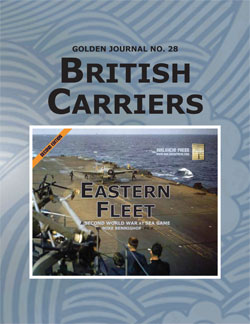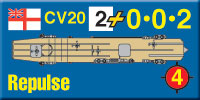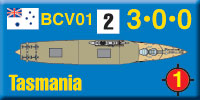| Golden Journal No. 28:
British Carriers
The British Carriers
by Mike Bennighof, Ph.D.
August 2022
 In Golden Journal No. 28: British Carriers we offer a whole squadron of unusual British aircraft carriers. But why? Yes, there is a reason behind them. In Golden Journal No. 28: British Carriers we offer a whole squadron of unusual British aircraft carriers. But why? Yes, there is a reason behind them.
The British delegation scored an astounding success at the Washington Naval Limitations talks. They traded the cancellation of battleships and battle cruisers that only existed on paper (the N3 and G3 types) for the scrapping of real American and Japanese ships that actually existed and were already under construction. Where Japanese and American taxpayers took a hit for these sacrifices, their British counterparts lost nothing. On top of that paper-for-steel swap, they finagled the tonnage limit on aircraft carrier conversions to allow them to turn three useless battle cruiser hulls into carriers while the Americans and Japanese had to settle for two apiece as neither had ships in the proper size category to squeeze three carriers out of the limit.
The Washington Naval Limitations Agreement allowed the major-power signatories to convert 66,000 tons’ worth of surface ships to aircraft carriers. The United States and Japan chose to rebuild two battle cruiser hulls of roughly 33,000 tons apiece (once completed as carriers). The British had held out for the 66,000-ton figure because it would allow them to convert all three of their light battle cruisers, ships with so little fighting value as gun-armed capital ships that they likely would have been scrapped regardless of any naval limitations.
 The failure of the Americans and Japanese to find common ground resulted in four American and two Japanese battle cruisers going straight from the shipyard to the scrapyard while no capital ship completed for the Royal Navy after the outbreak of war would be turned into cutlery (two formerly Turkish dreadnoughts would be sacrificed). The failure of the Americans and Japanese to find common ground resulted in four American and two Japanese battle cruisers going straight from the shipyard to the scrapyard while no capital ship completed for the Royal Navy after the outbreak of war would be turned into cutlery (two formerly Turkish dreadnoughts would be sacrificed).
Had the Americans insisted on a more equitable arrangement regarding aircraft carrier tonnage, and sought Japanese support, they likely could have salvaged more than two of the Lexington-class battle cruisers in carrier form. Britain had six battle cruisers suitable for conversion: Courageous, Glorious, Furious, Repulse, Renown and Hood.
 The huge Lexingtons displaced 43,500 tons; four of them would still outweigh the six British ships but the Americans would likely argue that four flight decks were less valuable than six, balancing the advantage in total size. The four Japanese Amagi class were only slightly smaller than the American battle cruiser, and Japan might be able to retain parity with the Americans in this one class of ship as they did in the actual treaty. The huge Lexingtons displaced 43,500 tons; four of them would still outweigh the six British ships but the Americans would likely argue that four flight decks were less valuable than six, balancing the advantage in total size. The four Japanese Amagi class were only slightly smaller than the American battle cruiser, and Japan might be able to retain parity with the Americans in this one class of ship as they did in the actual treaty.
And that’s the basis for our Eastern Fleet variant: the Royal Navy converts all six of its oil-fired wartime-built battle cruisers into aircraft carriers along the same lines as the first three. That allows the British to meet their needs in the active wartime theaters in the Atlantic and Mediterranean while giving the Eastern Fleet enough flight decks to directly challenge Japan’s First Air Fleet.
 As aircraft carriers, Repulse and Renown would have been somewhat larger than Courageous, allowing them to operate a larger air group (probably 60 planes compared to 48 for the smaller ships). In our variant set they’ve been constructed similarly to Courageous but larger (you can tell if you look closely at their drawings). As aircraft carriers, Repulse and Renown would have been somewhat larger than Courageous, allowing them to operate a larger air group (probably 60 planes compared to 48 for the smaller ships). In our variant set they’ve been constructed similarly to Courageous but larger (you can tell if you look closely at their drawings).
Hood, on the other hand, was a much larger battle cruiser and would have made for a much larger carrier. Like Renown she follows a similar pattern to Courageous, but her greater length allows for additional galleries of anti-aircraft weapons, and combined with her broader beam would have allowed a bigger air group – probably 72 planes. “The Mighty Hood” would have finally lived up to her press clippings in aircraft carrier guise; she would have been roughly the same size as the American carrier Lexington or Japanese Akagi.
 In addition to the fleet carriers converted from battle cruiser hulls, in our set of variant pieces the Eastern Fleet receives some less helpful additions as well. Several nations considered converting their oldest Treaty cruisers into light aircraft carriers. The first classes of heavy cruiser weren’t all that heavy, with inadequate protection. The American Salt Lake City, French Duquesne, Italian Trento and Argentine Almirante Brown all were considered for such a conversion, but all ultimately remained in their original form. In addition to the fleet carriers converted from battle cruiser hulls, in our set of variant pieces the Eastern Fleet receives some less helpful additions as well. Several nations considered converting their oldest Treaty cruisers into light aircraft carriers. The first classes of heavy cruiser weren’t all that heavy, with inadequate protection. The American Salt Lake City, French Duquesne, Italian Trento and Argentine Almirante Brown all were considered for such a conversion, but all ultimately remained in their original form.
The British apparently never considered such a fate for their County-class cruisers; these shared the same flaws as their contemporaries but the Royal Navy needed all of its cruisers to meet its world-wide deployments and more besides. The County-class hull was slightly smaller than that of the American Cleveland-class light cruisers, nine of which were converted into light aircraft carriers between 1941 and 1943. These Independence-class ships (as they were re-named) had extremely limited capabilities, operating about a third as many planes as the purpose-built Essex class. They possessed the virtues of speed and availableness; otherwise their small size led to many more flight-deck accidents and a limited capability for aircraft maintenance.
 British practice would have given small carriers converted from cruiser hulls an even smaller air group than that of Independence. Given the Royal Navy’s far-flung responsibilities the ability to send an aircraft carrier, even a small one, to distant stations would have been attractive (the small carrier Hermes, for example, served on the China Station in the 1920’s and 1930’s). During an actual conflict, they would have had limited combat power, though they likely would have had the speed to avoid Hermes’ fate British practice would have given small carriers converted from cruiser hulls an even smaller air group than that of Independence. Given the Royal Navy’s far-flung responsibilities the ability to send an aircraft carrier, even a small one, to distant stations would have been attractive (the small carrier Hermes, for example, served on the China Station in the 1920’s and 1930’s). During an actual conflict, they would have had limited combat power, though they likely would have had the speed to avoid Hermes’ fate
Hermes herself has been upgraded following plans made in the late 1930’s but never carried out as more valuable warships occupied the dockyards. She’s received the planned improvements to her armament (trading low-angle 4-inch guns for a dual-purpose battery while adding light anti-aircraft guns) and an engine overhaul.
Hybrid battleship-carriers were sketched by many navies between the world wars, an effort to combine big guns and aircraft. Almost all of those were designed as such from the keel up. Agincourt would have been one of the few existing ships capable of such a conversion, thanks to her great length and unusual design. Removing everything aft of the “Monday” turret and replacing it with a hangar structure and flight deck would provide a “carrier” portion of the ship about 450 feet long – the same as a Bogue-class escort aircraft carrier.
 Our version has a fairly large island and a pair of elevators, and could probably handle an air group of about thirty planes. She retains two of her 12-inch turrets. In a surface battle, her stores of aviation gasoline would make her fantastically vulnerable to a catastrophic end; it took a surprisingly long time for naval architects to recognize this fairly obvious problem with the concept. And just how air flow around those turrets would have impacted flight operations would require wind-tunnel testing that we did not conduct. Our version has a fairly large island and a pair of elevators, and could probably handle an air group of about thirty planes. She retains two of her 12-inch turrets. In a surface battle, her stores of aviation gasoline would make her fantastically vulnerable to a catastrophic end; it took a surprisingly long time for naval architects to recognize this fairly obvious problem with the concept. And just how air flow around those turrets would have impacted flight operations would require wind-tunnel testing that we did not conduct.
Had such a ship actually been built on Agincourt’s hull, she probably would have been converted into a through-deck carrier at some point in the 1930’s with her remaining turrets removed and the hangar and flight decks extended to the bow. But that would be much less fun for gaming purposes, so we’ve left the ship in her battleship-carrier guise. She’s part of the Royal Australian Navy; we included the ship in an earlier version of the Golden Journal some years ago and received a touching note from our one Tasmanian member. So we had to include Tasmania again.
 We did not, however, include any additional Japanese aircraft carriers – the purpose here is to make Eastern Fleet (the game) into a stand-up fight between the Eastern Fleet (the fleet) and the Japanese First Air Fleet. We did not, however, include any additional Japanese aircraft carriers – the purpose here is to make Eastern Fleet (the game) into a stand-up fight between the Eastern Fleet (the fleet) and the Japanese First Air Fleet.
To play the scenarios, you’re going to need pieces from Arctic Convoy (for more British ships and planes) and Coral Sea (for a few more Japanese ships and planes).
Click here to join the Gold Club.
See your Gold Club Insider newsletter for ordering information.
Sign up for our newsletter right here. Your info will never be sold or transferred; we'll just use it to update you on new games and new offers.
Mike Bennighof is president of Avalanche Press and holds a doctorate in history from Emory University. A Fulbright Scholar and NASA Journalist in Space finalist, he has published a great many books, games and articles on historical subjects; people are saying that some of them are actually good.
He lives in Birmingham, Alabama with his wife and three children. He will never forget his Iron Dog, Leopold.
Want to keep Daily Content free of third-party ads? You can send us some love (and cash) through this link right here.
|
